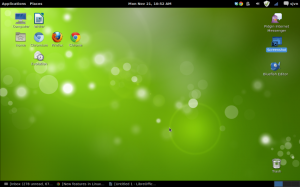Linux Mint 12: A Great desktop Linux stays Great

I've been using Linux and Unix desktops since the big interface question was C shell vs. Bourne instead of KDE vs. GNOME and I'm very impressed by the newest edition of the popular Mint Linux distribution.
Generally speaking, Mint is built on top of Ubuntu Linux. This version's foundation is Ubuntu 11.10. Unlike Ubuntu though, which has gone its own way with its touch-friendly Unity interface, Mint's developers have elected to stick with GNOME 3.2 desktop… sort of.
What Mint has actually done is support three different variations of the GNOME desktop. These are pure GNOME 3.2; Mint Gnome Shell Extensions (MGSE), which is a desktop layer on top of Gnome 3.2, that that makes it look and work like GNOME 2.3x; and MATE, a GNOME 2.x fork.
The Three Faces of Linux Mint Slideshow
Although Mint 12 has just been released and is now available for download, I've been using it since its last beta.
I first installed the new Mint on my primary Linux desktop. This is a Dell Inspiron 530S powered by a 2.2-GHz Intel Pentium E2200 dual-core processor with an 800-MHz front-side bus. This box has 4GBs of RAM, a 500GB SATA (Serial ATA) drive, and an Integrated Intel 3100 GMA (Graphics Media Accelerator) chip set.
I also put it on my main work laptop. This system is a Lenovo ThinkPad R61 with its 2.2GHz Intel Core 2 Duo processor T7500 and 2GBs of RAM. In other words, Mint worked well enough that that I went from experimenting with it to using it on my production systems even before it went final.
Both of these are older systems and far from being very powerful. In each case, though, Mint 12, Lisa, ran like a champ.
Along the way I found that, for me, GNOME/MGSE was the best interface. I continue to find GNOME 3.x to be more annoying than useful. I wanted to like MATE, since I'm very fond of the GNOME 2.x desktop, but it just isn't ready for prime-time yet. I kept running into errors. I'll be keeping my eye on it, but I can't recommend it for production use at this time.
MGSE does not turn GNOME 3.2 into a GNOME 2.32 clone. There are differences such as the use of a bottom panel for active applications. If MSGE doesn't meet your needs, I'd stick with Mint 11. Keep in mind though that, unless MATE matures in a hurry, for better or worse GNOME 3.x is going to stay Mint's default desktop.
Underneath Mint, you'll find the Linux 3.0 kernel. It also comes with the usual Linux open-source desktop programs. These include Firefox 7.01 for Web browsing; Banshee 2.2 for music management and playback; LibreOffice 3.4.3 for the office suite; Pidgin 2.1 for instant messaging; and Thunderbird 7.0.1 for e-mail.
These aren't all the programs I've choose, but Mint makes it easy to add Evolution, my favorite e-mail client to the system. It also includes Chromium, the pure open-source version of Google's Chrome Web browser. If you want Chrome itself you have to download it form the Web.
As before, in its DVD editions, Mint includes some proprietary software such as Adobe Flash and MP3 audio codecs. If you're a free software purist, Mint is not for you. Instead, you should be looking for a Linux distribution in the Free Software Foundation's list of free distros.
There is one "odd" addition to Mint. The default search engine in Firefox is DuckDuckGo. This is a new search engine that uses resources from other search engines, such as Yahoo, and crowd-sourced sites, such as Wikipedia. What makes it different from the others is that this search engine claims that it doesn't collect or share personal information. There is no search history, personal profile or any other information about you gathered, stored, sold, used, leaked, or uses it to bias--aka bubble--your search results based on your past search history. You can, of course, switch the default search engine to anything you want.
Installing Mint is a snap. All you need do is download the ISO, burn it to a CD, DVD, or USB stick and then re-boot your computer with it and follow the instructions. On my PCs, the entire process took about half-an-hour. One nice thing about Mint, and other Linux distros, is that they'll work well on old PCs with as little as 512MBs of RAM. For most people though I'd recommend running Mint on a system with at least 1GB of memory.
You cannot though do an in-place update of Mint 11. That's by design. Mint's developers feel that if you just upgrade an already existing Linux, you're likely to carry forward potential problems or out of date software. So, you'll need to back up and restore your home directories and files. I did this by backing them up to an attached USB drive. It's a trifle annoying, but it's not really a big deal.
Once in place, I again found that this new edition of Mint to be a pleasure to use. I think you will too.
Related Stories:
Linux Mint 12's Three Desktops
The Three Faces of Linux Mint Slideshow
